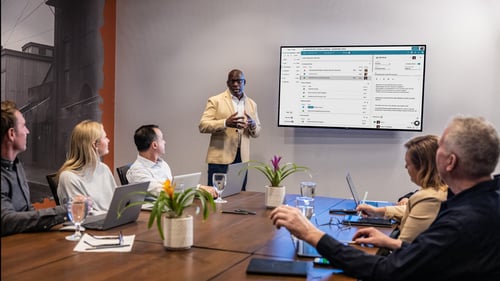Finding the Sweet Spot: How Long Should Your Meetings Last?
It’s easy to tell when a meeting is running too long — just look around the room (whether it’s a Zoom room or an actual, physical room with in-person attendees). You’ll see people becoming distracted, glancing at their phones, or turning their cameras off. These signs often make it clear that the meeting is losing its purpose, and there’s no getting some people back. Determining the appropriate duration of any meeting goes a long way in ensuring engagement and collaboration, alignment on next steps, and effective outcomes among your team members. The average meeting length runs between 30 minutes to an hour. However, factors such as meeting type, number of participants, and frequency can significantly impact this time frame.
The good news is that getting a handle on meetings that run too long is a relatively easy thing to do, and it starts with being aware of the typical run time for each type of meeting. In most cases, Daily Stand-Ups should be super quick and only cover the core issues of the week, running roughly 5–10 Minutes. Weekly Team Meetings can vary from 1–2 hours depending on the number of employees involved. Weekly 1-on-1s range from 30 minutes to an hour, and quarterly 1-on-1s typically run a full hour. Quarterly Planning Meetings tend to run 3 hours to a full day, depending on how many members of the Senior Leadership Team attend. And, last but not least, Annual Planning Meetings run 1–2 days to cover the full agenda. State of the Company Meetings bring the whole company together and run 1–2 hours, including time for Q&A at the end.
But make no mistake: Simply saying, “This should only take thirty minutes” does not solve the issue on its own. You need an effective agenda that provides the context team members need to meaningfully contribute. After all, if we’re going to put any amount of time on someone’s calendar, they should know why they’ve been invited and what they’re going to learn or contribute to the meeting.
You should also consider the number of attendees, the purpose of the meeting, the meeting frequency, and where everyone will be when the meeting starts — whether it’s in the office, working from home, or working remotely halfway around the world. You also want to be sure you adhere to the discipline of starting on time and ending on time.
Once you have a clear grasp on how to hold a meeting that is both effective and efficient, you’ll be well on your way to setting an appropriate meeting duration. Let’s dive a bit deeper.
Types of Meetings and Their Ideal Length
Meetings are at the heart of any company, providing alignment, boosting engagement, and helping to build company culture. Let’s break down a few key types of meetings every organization is bound to have at one level or another, along with their average run times:- Daily Stand-Ups: 5-10 Minutes
- Weekly Team Meetings: 1-2 hours
- Weekly 1-on-1s: 30 minutes to 1 hour
- Quarterly 1-on-1s: 1 hour
- Quarterly Planning Meetings: 3-7 hours
- Annual Planning Meetings: 1-2 days
- State of the Company Meetings: 1-2 hours
Daily Stand-Ups
These quick check-ins are great for teams with many shared blockers, like design or creative teams. But it’s still imperative to work through issues quickly so teams can get back to work. Schedule 10 minutes at the beginning of each day and adjust the timing as needed if you start to run over consistently.Weekly Team Meetings
We typically see Weekly Team Meetings clocking anywhere from 1–2 hours, depending on the agenda and number of attendees, many of whom may be raising issues or providing key updates. Weekly Team Meetings may run longer in periods of expansion or transition, so review your lists of Rocks (goals for the next quarter) and issues to find the ideal meeting length.
Weekly 1-on-1s
These meetings are integral for managers to communicate with their team members. Regularly scheduled meetings of 30 minutes to 1 hour allow time to review projects, answer questions, and eliminate blockers.
Quarterly 1-on-1s
Unlike weekly 1-on-1s, these meetings should solely review the largest Rocks from each quarter. It’s a great time to celebrate accomplishments, review career goals, and discuss what processes could be improved. Quarterly 1-on-1s typically run for an hour and benefit from a planned agenda.
Quarterly Planning Meetings
Quarterly Planning Meetings tend to run a full day for most Senior Leadership Teams (SLTs), half to three-quarter days for larger departments, and 3–4 hours for smaller teams.
Annual Planning Meetings
Annual Planning Meetings often vary in their run times. Their length will depend on the number of Rocks and key performance indicators (KPIs) to review, but a good benchmark is that they tend to run twice as long as your Quarterly Planning Meetings.
State of the Company Meetings
State of the Company meetings will vary in length depending on the size of the company and its performance. On average, they typically run 1-2 hours and include multiple presenters from your SLT, with about 15 minutes of Q&A at the end.
Find the Best Fit for Your Business
One of the biggest factors determining the right amount of time for each meeting is the size of the team and/or how many people will be attending. Following Ninety's rapid growth in 2023, our SLT is larger than the usual 5–7 members, so we extend our meeting times to accommodate the larger group. However, most standard-sized leadership teams need about 90 minutes for a Weekly Team Meeting.
Creating Your Meeting Agendas
An organized agenda can help your team stay focused and retain the most important information. Here’s our SLT's most commonly used agenda to frame things up.
- Segue — A time for quick personal and/or professional updates to keep us healthily connected
- Headlines — News that’s important to share (“I’ll be out next week”) but not tied to company goals
- Rock review — Confirmation that our Rocks (our 90-day goals) are on track for completion
- To-Dos — A 5-minute blitz through the list of things we committed to do by the end of the week
- Scorecard — A look at the KPIs and targets we’ve set to ensure everything is running well
- Raise, Discuss, and Resolve (RDR) — Dedicated time to address our short-term issues list (this is the bulk of the meeting)
- Conclude — Time for the attendees to rate the effectiveness of the meeting on a scale of 1–10
Quarterly Planning Meetings at Ninety include some elements of the Weekly Team Meetings but are larger in scope and consume at least a full day. Like most organizations, we use this time to review results from the previous quarter, tackle long-term issues, and set goals for the next quarter, among other agenda items. And, as you might have guessed, Annual Planning Meetings take it up another notch, requiring at least two days to properly sift through what's surely a packed agenda.
As for the remaining meetings on our list, we find 30–45 minutes to be sufficient for most 1-on-1 meetings, as they’re likely held on a weekly cadence. Daily stand-ups are a fraction of that, maybe 5–10 minutes. It’s the quickest of check-ins to ensure a team is highly connected and aligned without requiring too much time or energy from the participants.
The Risks of Meetings That Are Too Long
As you might imagine, meetings with a duration that’s “just right” lead to better decision-making, increased productivity, and reduced frustration.
So what are the implications of meetings that aren’t the right length?
Spotting the signs of disengaged team members isn’t all that hard, but there’s often a carryover effect that compounds over time. Just imagine if certain team members decide the next meeting could be a waste of their time and opt not to join at all. That can become a significant challenge.
Not only does decreased engagement or attendance reduce the team’s productivity and morale, but there’s also a real risk of derailing the tasks and goals the meeting aims to address in the first place.
We can head all this off by starting on time, ending on time, and using a few tools to help the process. Perhaps the best time manager is found right in the Ninety Meetings tool, where an in-app timer keeps everyone on track according to the time limits set for each agenda item. Running long on a section? The timer turns red to alert you. With this visual reminder, the balance of time for remaining agenda items can be slightly modified to help get things back on track.
Best Practices for Optimizing Meetings
It’s meeting time — the agenda is established, and issues are prioritized. There’s a firm start and stop time, the duration of the meeting feels right, and the right people are in the room, either physically or virtually.
So, you might wonder, how can the meeting be optimized even further? Here are a few suggestions to keep people focused and engaged:
- Have someone run the meeting.
- Have someone else be the scribe for the meeting.
- Keep the meeting short and to the point. As we like to say at Ninety, “Less is more (until it’s not).”
- Avoid tangents that move the conversation off-topic. If you’re the one running the meeting, part of your job is to keep an eye on the time and help us avoid those tangents.
- Take appropriate breaks every 60–90 minutes during long meetings. A quick “temp check” of the room will let you know when the time is right.
- Adopt a “no-meeting day" policy, and increase remote work options. It’s a powerful combination to give some time back to team members.
Make the Most of Your Meetings
Are you ready to fine-tune your meetings, improve productivity, and create a more positive meeting culture?Fortunately, there’s a way to manage and optimize your meeting length based on the type of meeting and the desired outcomes. Ninety’s Meetings tool lets you automate and keep your meetings on track for maximum productivity and engagement.
Optimize your meeting time for success. Start your first meeting for free in Ninety today.
Ninety is an innovative, cloud-based platform built for remote, hybrid, and onsite teams that want to work smarter and more effectively — together.





.jpg?width=500&name=large_Generic_Blog_Header29_1920_x_1080%20(1).jpg)

